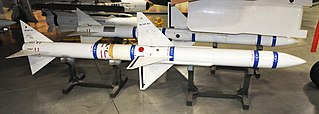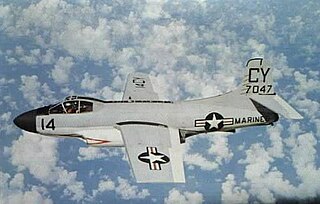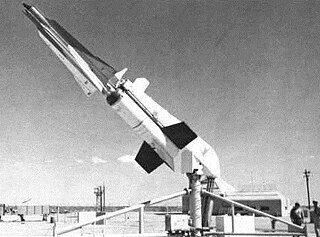
The AIM-7 Sparrow is an American medium-range semi-active radar homing air-to-air missile operated by the United States Air Force, United States Navy, United States Marine Corps, and various other air forces and navies. Sparrow and its derivatives were the West's principal beyond visual range (BVR) air-to-air missile from the late 1950s until the 1990s. It remains in service, although it is being phased out in aviation applications in favor of the more advanced AIM-120 AMRAAM.
The AIM-54 Phoenix is an American radar-guided, long-range air-to-air missile (AAM), carried in clusters of up to six missiles on the Grumman F-14 Tomcat, its only operational launch platform.

A cruise missile is a guided missile used against terrestrial or naval targets, that remains in the atmosphere and flies the major portion of its flight path at an approximately constant speed. Cruise missiles are designed to deliver a large warhead over long distances with high precision. Modern cruise missiles are capable of traveling at high subsonic, supersonic, or hypersonic speeds, are self-navigating, and are able to fly on a non-ballistic, extremely low-altitude trajectory.

An interceptor aircraft, or simply interceptor, is a type of fighter aircraft designed specifically for the defensive interception role against an attacking enemy aircraft, particularly bombers and reconnaissance aircraft. Aircraft that are capable of being or are employed as both ‘standard’ air superiority fighters and as interceptors are sometimes known as fighter-interceptors. There are two general classes of interceptor: light fighters, designed for high performance over short range; and heavy fighters, which are intended to operate over longer ranges, in contested airspace and adverse meteorological conditions. While the second type was exemplified historically by specialized night fighter and all-weather interceptor designs, the integration of mid-air refueling, satellite navigation, on-board radar and beyond visual range (BVR) missile systems since the 1960s has allowed most frontline fighter designs to fill the roles once reserved for specialised night/all-weather fighters.

An air-to-air missile (AAM) is a missile fired from an aircraft for the purpose of destroying another aircraft. AAMs are typically powered by one or more rocket motors, usually solid fueled but sometimes liquid fueled. Ramjet engines, as used on the Meteor, are emerging as propulsion that will enable future medium- to long-range missiles to maintain higher average speed across their engagement envelope.

The Douglas F3D Skyknight is an American twin-engined, mid-wing jet fighter aircraft designed and manufactured by the Douglas Aircraft Company.

The AGM-122 Sidearm was an American air-to-surface anti-radar missile produced between 1986 and 1990. While not as capable as newer anti-radiation missiles, they were cheaper and lighter in weight allowing more versatile deployment.

The Douglas F6D Missileer was a proposed carrier-based fleet defense fighter designed by Douglas Aircraft Company in response to a 1959 United States Navy requirement. It was designed to be able to loiter for extended periods at a relatively long distance from the Navy's aircraft carriers, engaging hostile aircraft 100 miles (160 km) away with its powerful radar and long-range missiles. Since the enemy would be fired on long before they reached visual range, the aircraft had little dogfighting capability and was strictly subsonic. When doubts were expressed about the Missileer's ability to defend itself after firing its missiles, the value of the project was questioned, leading to its cancellation. Some of the Missileer's systems, primarily the engines, radar, and missiles, continued development in spite of the cancellation, eventually emerging on the ill-fated General Dynamics–Grumman F-111B and successful Grumman F-14 Tomcat years later.

The Hughes AIM-47 Falcon, originally GAR-9, was a very long-range high-performance air-to-air missile that shared the basic design of the earlier AIM-4 Falcon. It was developed in 1958 along with the new Hughes AN/ASG-18 radar fire-control system intended to arm the Mach 3 XF-108 Rapier interceptor aircraft and, after that jet's cancellation, the YF-12A. It was never used operationally, but was a direct predecessor of the AIM-54 Phoenix used on the Grumman F-14 Tomcat.

The Hughes AIM-4 Falcon was the first operational guided air-to-air missile of the United States Air Force. Development began in 1946; the weapon was first tested in 1949. The missile entered service with the USAF in 1956.
A beyond-visual-range missile (BVR) is an air-to-air missile (BVRAAM) that is capable of engaging at ranges of 20 nmi (37 km) or beyond. This range has been achieved using dual pulse rocket motors or booster rocket motor and ramjet sustainer motor.

Bendix RIM-8 Talos was a long-range naval surface-to-air missile (SAM), among the earliest SAMs to equip United States Navy ships. The Talos used radar beam riding for guidance to the vicinity of its target, and semi-active radar homing (SARH) for terminal guidance. The four antennas surrounding the nose were SARH receivers, which functioned as a continuous wave interferometer. A solid rocket booster provided thrust for launch and a Bendix ramjet powered its flight to the target, with the warhead serving as the ramjet's compressor.

The Fairchild SM-73 was a planned sub-sonic, jet-powered, long-range, ground-launched decoy cruise missile. XSM-73 was the designation for the development version. Development began in 1952 with conceptual studies and ended when the program was canceled in 1958 after 15 test flights but before any operational deployment. The operational concept was to base squadrons of XM-73s at various locations in the United States and if necessary launch the aircraft as part of a strategic bomber attack. The aircraft would fly autonomously under inertial guidance towards the target area, using radar reflectors and electronic countermeasures to imitate American bombers and thus confuse and saturate enemy air defenses. The program was cancelled because the missile was not able to simulate a B-52 bomber on radar.

The AN/AWG-9 and AN/APG-71 radars are all-weather, multi-mode X band pulse-Doppler radar systems used in the F-14 Tomcat, and also tested on TA-3B. It is a long-range air-to-air system capable of guiding several AIM-54 Phoenix or AIM-120 AMRAAM missiles simultaneously, using its track while scan mode. The primary difference between the AWG-9 and APG-71 is the replacement of the former's analog computer with a digital computer. Both the AWG-9 and APG-71 were designed and manufactured by Hughes Aircraft Company's Radar Systems Group in Los Angeles; contractor support was later assumed by Raytheon. The AWG-9 was originally created for the canceled Navy F-111B program.

The Raduga KSR-5 was a long-range, air-launched cruise missile and anti ship missile developed by the Soviet Union. It was essentially a scaled down version of the Kh-22 'Kitchen', built to be carried by the less capable Tu-16.

Typhon was a missile system developed by the United States Navy in the late 1950s, intended to serve as an integrated air-defense system for Navy fleets. Consisting of the SAM-N-8 Typhon LR, later designated RIM-50A, and the SAM-N-9 Typhon MR, later RIM-55A, paired with the AN/SPG-59 radar system, the cost of the Typhon system led to it being cancelled in favor of the Standard Missile program.

The AAM-A-1 Firebird was an early American air-to-air missile, developed by the Ryan Aeronautical Company. The first air-to-air missile program developed for the United States Air Force, the Firebird was extensively tested in the late 1940s; although it proved successful in testing, it was soon obsolete due to the rapid advances in aircraft and missile technology at the time and did not enter production.

The AAM-N-4 Oriole was an early American air-to-air missile, developed by the Glenn L. Martin Company for the United States Navy. Designed for launch from carrier-based aircraft, the missile programme was cancelled before flight testing began, and the missiles produced were utilized as test vehicles.

The AAM-N-5 Meteor was an early American air-to-air missile, developed by the Massachusetts Institute of Technology and Bell Aircraft for the United States Navy. Initially, both air-launched and ship-launched versions were considered. Versions designed for launch from carrier-based aircraft proceeded to the flight testing stage before the project was cancelled.


















